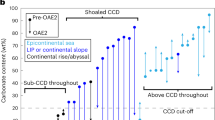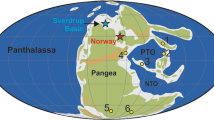Abstract
During the Cretaceous period (∼145–65 million years ago), there were several periods of global ocean anoxia, each lasting less than one million years. These events, known as ocean anoxic events, were marked by significant increases in organic carbon burial1, and are generally attributed to increased primary productivity in surface waters2. The details underpinning the initiation, maintenance and termination of these events, however, remain equivocal. Here we present sulphur isotope data spanning the Ocean Anoxic Event 2 (about 94.5 million years ago) from sedimentary rocks in Colorado that were formed in the Western Interior Seaway; this seaway ran north–south, splitting North America during the Cretaceous. Sulphate levels increased rapidly from relatively low background levels at the onset of the event, most likely from the release of sulphur by massive volcanism, and fell during the anoxic event. We infer that the input of sulphate facilitated increased carbon remineralization, which enhanced nutrient recycling and increased global primary productivity, eventually resulting in widespread ocean anoxia. Our scenario indicates that Ocean Anoxic Event 2 may have persisted until sulphate levels were stabilized by the formation and burial of the sulphur mineral pyrite, which returned primary productivity to background levels. We suggest that fluctuations in sulphate levels may have regulated the marine carbon cycle during past periods of low oceanic sulphate concentration.
This is a preview of subscription content, access via your institution
Access options
Subscribe to this journal
Receive 12 print issues and online access
$259.00 per year
only $21.58 per issue
Buy this article
- Purchase on Springer Link
- Instant access to full article PDF
Prices may be subject to local taxes which are calculated during checkout


Similar content being viewed by others
References
Schlanger, S. O. & Jenkyns, H. C. Cretaceous anoxic events: Causes and consequences. Geol. Mijnb. 55, 179–184 (1976).
Kuypers, M. M. M., Pancost, R. D., Nijenhuis, I. A. & Damste, J. S. S. Enhanced productivity led to increased organic carbon burial in the euxinic North Atlantic basin during the late Cenomanian oceanic anoxic event. Paleoceanography 17, 1–13 (2002).
Pratt, L., Arthur, M., Dean, W. & Scholle, P. The Evolution of the Western Interior Basin. Vol. 39. Geological Association of Canada, Special Paper. 333–353 (1993).
Sageman, B. B., Meyers, S. R. & Arthur, M. A. Orbital timescale and new C-isotope record for Cenomanian–Turonian boundary stratotype. Geology 34, 125–128 (2006).
Arthur, M. A., Dean, W. E. & Schlanger, S. O. Variations in the global carbon cycle during the Cretaceous related to climate, volcanism, and changes in atmospheric CO2; Natural variations Archean to present. AGU Geophys. Monogr. 32, 504–529 (1985).
Mort, H. P. et al. Phosphorus and the roles of productivity and nutrient recycling during Oceanic Anoxic Event 2. Geology 35, 483–486 (2007).
Dean, W. E. & Arthur, M. A. Iron–sulfur–carbon relationships in organic carbon rich sequences. I. Cretaceous western interior seaway. Am. J. Sci. 289, 708–743 (1989).
Hetzel, A., Böttcher, M. E., Wortmann, U. G. & Brumsack, H. Paleo-redox conditions during OAE2 reflected in Demerara Rise sediment geochemistry (ODP Leg 207). Palaeogeogr. Palaeoclimatol. Palaeoecol. 273, 302–328 (2009).
Arthur, M. A. Encyclopedia of Volcanoes (Academic, 2000).
Hansen, K. W. & Wallmann, K. Cretaceous and Cenozoic evolution of seawater composition, atmospheric O2 and CO2: A model perspective. Am. J. Sci. 303, 94–148 (2003).
Canfield, D. E. Isotope fractionation by natural populations of sulphate-reducing bacteria. Geochim. Cosmochim. Acta 65, 1117–1124 (2001).
Paytan, A., Kastner, M., Campbell, D. & Thiemens, M. H. Seawater sulfur isotope fluctuations in the Cretaceous. Science 304, 1663–1665 (2004).
Ohkouchi, N. et al. Sulfur isotope records around Livello Bonarelli (northern Apennines, Italy) black shale at the Cenomanian–Turonian boundary. Geology 27, 535–538 (1999).
Sinton, C. W. & Duncan, R. A. Potential links between ocean plateau volcanism and global ocean anoxia at the Cenomanian–Turonian boundary. Econ. Geol. 92, 836–842 (1997).
Kerr, A. C. Oceanic plateau formation: A cause of mass extinction and black shale deposition around the Cenomanian–Turonian boundary. J. Geol. Soc. Lond. 155, 619–626 (1998).
Turgeon, S. C. & Creaser, R. A. Cretaceous oceanic anoxic event 2 triggered by a massive magmatic episode. Nature 454, 323–326 (2008).
Snow, L. J., Duncan, R. A. & Bralower, T. J. Trace element abundances in the Rock Canyon Anticline, Pueblo, Colorado, marine sedimentary section and their relationship to Caribbean plateau construction and oxygen anoxic event 2. Paleoceanography 20, PA3005 (2005).
Lowenstein, T. K., Hardie, L. A., Timofeeff, M. N. & Demicco, R. V. Secular variation in seawater chemistry and the origin of calcium chloride basinal brines. Geology 31, 857–860 (2003).
Wortmann, U. G. & Chernyavsky, B. M. Effect of evaporite deposition on Early Cretaceous carbon and sulphur cycling. Nature 446, 654–656 (2007).
Jørgensen, B. B. A thiosulphate shunt in the sulfur cycle of marine sediments. Science 249, 152–154 (1990).
Burke, K. & Sengör, C. Ten metre global sea-level change associated with South Atlantic Aptian salt deposition. Mar. Geol. 83, 309–312 (1988).
Caraco, N. F., Cole, J. J. & Likens, G. E. Evidence for sulphate-controlled phosphorus release from sediments of aquatic systems. Nature 341, 316–318 (1989).
Caraco, N. F., Cole, J. J. & Likens, G. E. Sulphate control of phosphorus availability in lakes. Hydrobiologia 253, 275–280 (1993).
Boudreau, B. P. & Westrich, J. T. The dependence of bacterial sulphate reduction on sulphate concentration in marine sediments. Geochim. Cosmochim. Acta 48, 2503–2516 (1984).
Ingall, E. D., Bustin, R. M. & Van Cappellen, P. Influence of water column anoxia on the burial and preservation of carbon and phosphorus in marine shales. Geochim. Cosmochim. Acta 57, 303–316 (1993).
Murray, T. E. The correlation between iron sulfide precipitation and hypolimnetic phosphorus accumulation during one summer in a softwater lake. Can. J. Fish. Aquat. Sci. 52, 1190–1194 (1995).
Van Cappellen, P. V. & Ingall, E. D. Redox stabilization of the atmosphere and oceans by phosphorus-limited marine productivity. Science 271, 493–496 (1996).
Habicht, K. S., Gade, M., Thamdrup, B., Berg, P. & Canfield, D. E. Calibration of sulphate levels in the Archean ocean. Science 298, 2372–2374 (2002).
Hurtgen, M. T., Halverson, G. P., Arthur, M. A. & Hoffman, P. F. Sulfur cycling in the aftermath of a 635-Ma snowball glaciation: Evidence for a syn-glacial sulfidic deep ocean. Earth Planet. Sci. Lett. 245, 551–570 (2006).
Obradovich, J. Evolution of the Western Interior Basin. Vol. 39. Geological Society of Canada Special Paper. 379–396 (1993).
Acknowledgements
We are grateful for reviews by L. Kump, H. Mort and U. Wortmann.
Author information
Authors and Affiliations
Contributions
M.T.H. conceived and wrote the paper with contributions from B.B.S. and D.D.A. D.D.A. provided the geochemical data, M.T.H. carried out the modelling, and all authors provided intellectual input.
Corresponding author
Ethics declarations
Competing interests
The authors declare no competing financial interests.
Supplementary information
Supplementary Information
Supplementary Information (PDF 327 kb)
Rights and permissions
About this article
Cite this article
Adams, D., Hurtgen, M. & Sageman, B. Volcanic triggering of a biogeochemical cascade during Oceanic Anoxic Event 2. Nature Geosci 3, 201–204 (2010). https://doi.org/10.1038/ngeo743
Received:
Accepted:
Published:
Issue Date:
DOI: https://doi.org/10.1038/ngeo743
This article is cited by
-
Triassic/Jurassic bivalve biodiversity dynamics: biotic versus abiotic factors
Arabian Journal of Geosciences (2023)
-
CO2 and temperature decoupling at the million-year scale during the Cretaceous Greenhouse
Scientific Reports (2017)
-
Prevailing oxic environments in the Pacific Ocean during the mid-Cretaceous Oceanic Anoxic Event 2
Nature Communications (2011)
-
High sea-surface temperatures during the Early Cretaceous Epoch
Nature Geoscience (2011)
-
Geochemical evidence for widespread euxinia in the Later Cambrian ocean
Nature (2011)



